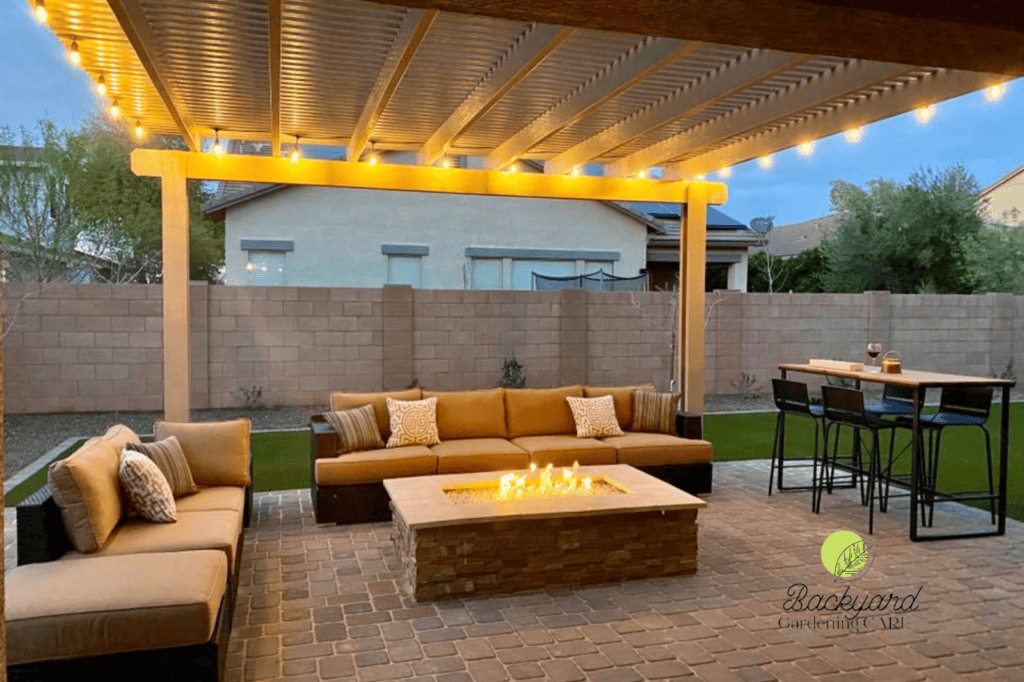How to Anchor a Pergola to Pavers? 4 best ways to Anchor a Pergola to Pavers.
A pergola is a beautiful addition to any outdoor space, providing both shade and architectural interest. Adding a pergola to your outdoor space adds aesthetic appeal and provides a functional space for relaxing or entertaining.
However, ensuring your pergola is secure and properly anchored is crucial to prevent disaster during high winds or inclement weather. Without proper anchoring, your beautiful pergola can become a safety hazard. Anchoring a pergola to pavers requires a specific method to ensure stability and safety.
Anchoring a pergola to pavers can seem tricky, but it can be done safely and securely with the right tools and techniques. In this article, we’ll show you how to anchor a pergola to pavers step-by-step so that you can enjoy your beautiful new outdoor space with peace of mind.

Read on to learn how to anchor a pergola to pavers and ensure your structure is safe and secure for many years.
The Importance of Properly Anchoring Your Pergola to Pavers
There is no doubt that pergolas can be a great addition to any backyard. They provide shade, shelter, and an aesthetic appeal that can’t be beaten. However, your pergola can become a safety hazard if you’re not careful.
One of the most important aspects of building a pergola is anchoring it properly to the ground. This section discusses the importance of properly anchoring your pergola to pavers. Why is it so important to anchor your pergola?
It is important to ensure that your pergola is properly anchored to ensure its stability and safety. It is very easy for your pergola to get knocked over by strong winds or heavy rains if it is not anchored properly.
Not only can this cause injury, but it can also result in expensive damages to your property. You can avoid these potential hazards by properly anchoring your pergola to pavers.

What Are Pavers, and Why Are They Good for Anchoring a Pergola?
Pavers are flat pieces of stone, concrete, or other materials that are used to create a solid surface for patios, walkways, and other outdoor areas, pavers are definitely a good solution for fixing a muddy yard too.
They are a great choice for anchoring a pergola because they provide a stable base that won’t shift over time. Pavers are also durable and easy to maintain, making them popular for outdoor projects.
How Do You Properly Anchor a Pergola to Pavers?
There are several methods for anchoring a pergola to pavers, but the most common is to use concrete anchors. Concrete anchors are metal hardware that is designed to be embedded in concrete or masonry.
You’ll need to follow these steps to use concrete anchors to anchor your pergola to the pavers. So, how do you properly anchor your pergola to pavers?
- 1. Choose the right pavers: When selecting the pavers for your pergola, make sure they are strong and durable enough to support the weight of the structure. Concrete or brick pavers are popular choices for their strength and stability.
- 2. Install the pavers correctly: The pavers should be installed on a flat and level surface with a solid foundation of compacted soil or gravel. This will provide a stable base for your pergola.
- 3. Use the right hardware: In order to properly anchor your pergola to the pavers, you will need the right hardware. This typically includes heavy-duty brackets or anchors designed to secure the pergola to the pavers. Be sure to choose hardware appropriate for your pergola’s weight and size.
- 4. Follow the manufacturer’s instructions: Every pergola is different, so it’s important to follow the manufacturer’s instructions for installation. This will ensure that your pergola is anchored correctly and safely.
To ensure the safety of your family and guests, as well as the longevity of your pergola, you must anchor it properly to the pavers. By following these simple tips, you can enjoy your pergola for years to come without any worries. So, take the time to do it right and enjoy the shade and beauty of your pergola with peace of mind.
The Ways to Anchor a Pergola to Pavers.
A pergola is a beautiful addition to any outdoor space, providing shade and a cosy atmosphere for relaxation and entertainment. However, anchoring a pergola to pavers can be challenging, especially if you want to ensure it is secure and stable.

Fortunately, there are several ways to anchor your pergola to pavers, and in this part, we’ll explore some of the most effective methods.
Installing Post Brackets into Pavers.
One popular method is to use post brackets specifically designed for drilling into existing pavers. These brackets feature holes that align with the pergola supports, allowing for a secure attachment.
However, caution must be exercised to avoid damaging the pavers during drilling. It’s important to use appropriate drill bits that can penetrate the pavers without causing cracks.
Additionally, masonry screws are essential for gripping the pavers and maintaining the pergola’s stability. It’s advisable to have spare pavers on hand in case any become damaged during the process.
Post Footings and Pavers
If you’re looking for a reliable method to secure your pergola, removing the pavers and adding post footings may be the way to go. Although it requires more work, the results are excellent.

The post footing brackets are designed to hold the pergola and should be set in wet concrete, which will harden and provide stability. To execute this approach, you’ll need to take out the old pavers and pour fresh concrete to serve as the new base.
We highly recommend seeking professional assistance for this process. Also, it’s crucial to ensure the post footings are appropriate for your pergola’s dimensions to ensure a proper fit.
Weight Bags
Weight bags can be a quick and inexpensive way to anchor a light pergola to pavers when other options are not available. This method involves placing bags filled with weights at the base of each leg of the pergola to hold it in place.
It’s important to keep in mind that this technique should only be used as a last resort and is not recommended for heavier pergolas. For long-term stability and security, consider transitioning to one of the more secure anchoring methods mentioned earlier.
Using a Concrete Post Base
Looking for ways how to anchor a pergola to concrete? One effective method is to use a concrete post base. However, it’s important to note that this method may require professional assistance and pouring concrete.
To execute this method, you need to put large containers like barrel planters around each leg of the pergola. Once you have placed the legs in the containers, pour concrete to fill them.
This method will ensure that the pergola is stable with time as the concrete dries. However, it’s crucial to check if the pavers underneath the containers can support the weight without cracking.
Remember to consider your pergola’s size, weight, and design when selecting an anchoring method. Additionally, consult local building codes and regulations to comply with specific pergola installation requirements. You can enjoy a stable and secure pergola on your paver surface by choosing an appropriate anchoring method.
How to Anchor a Pergola Without Drilling?
Anchoring a pergola without drilling can be a lifesaver, especially if you have limited options for securing it. I faced this challenge myself when I wanted to set up a pergola on my wooden deck, which I didn’t want to damage with screws or anchors.
After some research, I discovered a simple and effective solution: sandbags. By placing sandbags at each corner of the pergola, I was able to achieve stability without any drilling. This method not only preserved my deck but also proved handy when I decided to relocate the pergola to different spots in my yard.
Sandbags not only kept the pergola stable but also had an unexpected benefit for my wet yard – they helped with drainage and prevented soggy ground around the patio. So, if you’re looking for a versatile and non-invasive way to anchor your pergola, consider giving sandbags a try.
Use Ground Stakes
Using ground stakes is one of the easiest and most affordable methods of anchoring your pergola, as it is also one of the most effective. These stakes are driven into the ground, providing a sturdy foundation for your pergola.
They work particularly well if your pergola is going to be placed on grass or dirt. However, keep in mind that this option may not be suitable for all types of soil.
Use Sandbags
Another option for anchoring your pergola without drilling is to use sandbags. Sandbags can also be a good solution for drying up a wet yard fast. This method is ideal for those with a patio or deck that cannot be drilled into. Simply place sandbags on each corner of the pergola to keep it stable. There are a number of benefits to this option, particularly if you need to move your pergola around on a frequent basis.
Use Concrete Blocks
A more permanent solution for anchoring your pergola can be found in concrete blocks if you’re looking for a more permanent solution. This method is ideal for those who have a concrete or paver patio in their home lawn or backyard.
Simply place the concrete blocks on each corner of the pergola and secure them with construction adhesive. This will provide a sturdy foundation for your pergola without the need for drilling.
Use Deck Brackets
You can use deck brackets to anchor your pergola if you have a deck. These brackets are designed to attach to your deck without drilling. Essentially, you need to attach the brackets to your floor, and then you can attach your pergola to the brackets after that. This option is particularly useful if you want to remove your pergola during winter.
Use Retaining Wall Blocks
Depending on whether or not you have a retaining wall, you can anchor your pergola with retaining wall blocks. This method is similar to using concrete blocks, but the retaining wall blocks are specifically designed to work with retaining walls.
Simply place the blocks on each corner of the pergola and secure them with construction adhesive. Ultimately, there are several ways to anchor your pergola without drilling.
Whether you choose to use ground stakes, sandbags, concrete blocks, deck brackets, or retaining wall blocks, you can rest assured that your pergola will be stable and secure.
Just remember to choose the best method for your particular situation and always follow the manufacturer’s instructions for installation. With these tips in mind, you can enjoy your beautiful pergola without the need for drilling into your lawn or garden.
Regular Maintenance to Ensure Long-lasting Stability
The pergola is an excellent addition to your backyard or garden, providing shade and a beautiful architectural touch. However, like any outdoor structure, they require regular maintenance to ensure their longevity and stability. You can keep your pergola looking great for years by taking a few simple steps.
1. Check for Damage
It is essential to regularly check your pergola for any signs of damage, as this is the first step in maintaining it. This includes inspecting the wood for cracks, splits, or warping and checking the parts for rust or other signs of wear. Catching and repairing damage early on can prevent it from becoming a larger issue down the line.
2. Clean Regularly
Undoubtedly, dirt, dust, and debris will accumulate on your pergola over time, leading to discolouration and even damage to the wood. To prevent this, it’s important to clean your pergola regularly.
The best method of removing any build-up is to use a soft-bristled brush or a pressure washer on a low setting while using a soft-bristled brush. It’s important to avoid using harsh chemicals that could damage the wood or stain.
3. Apply a Protective Coating for Staining and Sealing
A protective coating is a good idea if you want to protect your pergola against the Staining and sealing elements and keep it looking good for a long time. This can be in the form of a sealant, stain, or paint.
A sealant will help protect the wood from moisture damage, while a stain or paint can add colour and style to your pergola. Make sure to follow the manufacturer’s instructions and reapply the coating as needed.
4. Trim Plants and Vines
If you’ve got plants, grass, weeds, or vines encroaching on or around your pergola, keeping them well-trimmed is crucial. Allowing them to overgrow can lead to damage to the wood and even invite pests and other problems.
It’s a good idea to schedule weekly mowing and regular pruning sessions to maintain the tidiness of your pergola and preserve its structural integrity. By staying on top of this maintenance, you’ll ensure that your pergola remains both aesthetically pleasing and sturdy for the long term.
5. Check for Pest Infestations
Wood-boring insects, such as termites and carpenter ants, can cause significant damage to your pergola over time. Regularly inspect your structure for signs of pest infestations, such as sawdust or small holes in the wood, So whether you’re dealing with fleas, ticks, mosquitos, or other unwanted pests, this information will help you to decide which pest control solution is right for your lawn and Pergola. can help you catch and treat the problem early on.
Consider hiring a professional pest control service to inspect your pergola and treat infestations. By following these simple maintenance tips, you can ensure that your pergola remains stable and beautiful for years to come.
Regular inspection, cleaning, and upkeep allow you to enjoy your outdoor space with peace of mind knowing that your pergola is in great shape.
Conclusion
Anchoring a pergola to pavers is a relatively simple process that requires careful planning and attention to detail. Following the steps outlined in this guide, you can ensure that your pergola is securely anchored to your pavers, providing a stable and durable structure that will stand the test of time.
Remember always to use the appropriate tools and materials and seek professional help if you need clarification on any aspect of the installation process. With a little effort and patience, you can enjoy the beauty and functionality of your pergola for many years to come.
FAQs
How Do I Anchor My Pergola to Pavers?
To anchor a pergola to pavers, you will need to use anchor bolts or lag screws. First, determine the location of the posts on the pavers and mark the spots.
Then, drill holes in the pavers where the posts will go and insert the anchor bolts or lag screws.
Make sure they are secured tightly and level. Once the anchors are in place, attach the posts using brackets or bolts.
It is important to ensure that the pergola is securely anchored to the pavers to prevent it from tipping over or being damaged by strong winds or other weather conditions.
Can You Screw Pergola Into Pavers?
Yes, you can screw a pergola into pavers. However, it is important to note that the stability and strength of the pergola will depend on the quality and thickness of the pavers.
It is recommended to use thick and sturdy pavers that are at least 2 inches thick to ensure the pergola is securely anchored.
Additionally, it is important to use the appropriate screws and anchors to attach the pergola to the pavers, as this will further enhance its stability and durability.
Can You Anchor to Pavers?
Yes, you can anchor to pavers, but it depends on the type of surface and the weight of the object you want to anchor. Pavers are typically made of concrete, brick, or stone, providing a stable base for anchoring objects.
However, using the appropriate anchors and accessories is important to ensure that the object is securely anchored to the pavers. If you need clarification on the type of anchors or hardware to use, it is recommended that you consult a professional for guidance.
Albert Phipps

Hello, I’m Albert Phipps, your trusted professional gardener. I have a deep passion for nurturing nature’s beauty, With years of experience in landscaping. I’m dedicated to creating lush, vibrant gardens and outdoor spaces.
If you’re seeking guidance on plant selection, grass care, pest control products, garden design, or lawn maintenance tips, don’t hesitate to get in touch. I’m here to help you transform your outdoor space into a thriving and serene landscape.






